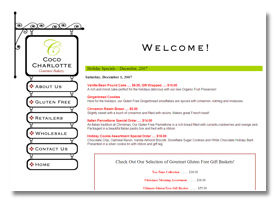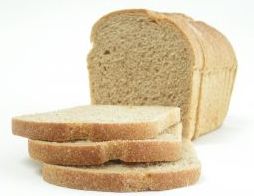So, as many of you know, I've learned over the past year or so that my body doesn't tolerate gluten. Yeah, it's a pain, but I feel so much better when I don't eat it...not to mention all the long-term effects. In fact, the Celiac could very well have played a part in my big drama episode last year with the multiple clots in both lungs--my doctor is investigating this for me.

Living gluten-free is much easier than it used to be. There are so many yummy products out now. We even have a gluten-free bakery in Grand Rapids! In fact, I just finished the website for
Coco Charlotte. The owner, Erin, studied in Paris, so she
knows baking! I got a pumpkin cheesecake for Thanksgiving that was totally amazing! I could go on and on...
Also related to this subject, I've also been given the leadership responsibility for our local
Celiac Support Network in Barry County. We've just had one meeting since I have been leading it, but it went really well and we had a lot of new people show up. The word is getting out and I think we're going to be able to help a lot of people with our group. We meet on the 3rd Monday of each month...visit the site for more information.

The boys have finished up their first trimester in school and they did an amazing job academically! Christopher has a 4.0 GPA (including one AP--college--class) and Ian is right up there with a 3.94 GPA. They're both great kids and we're very proud of them.
We had a kind of fun week at work this week. We had a cubicle decorating contest and Slipper Day, which was kind of fun. There are
pictures on my Flickr site, if you're interested.
I know it's not October (Breast Cancer Awareness Month), but if you haven't had a mammogram recently, please make that appointment! When it hits someone in your family, you realize the importance...just kind of drives it home and you make the call. Don't wait for that, though...make that appointment today!
Have fun getting ready for Christmas! I'll try to post again really soon!
Labels: Celiac, Dramatic Design, family, gluten-free, school, work
So much has been happening! I'm not sure where to start! I guess I'll start with the boys.
Christopher was nominated as one of the Students of the Month for September. (I'll try to get a scan of the newspaper picture up soon.) He has really enjoyed marching band this year and even thinks that he wants to pursue a career as a high school music teacher. He has gotten very serious about his trumpet playing, too. He has decided to enter the Solo and Ensemble Competition in January. We took him to a college fair last week, so he's already considering where he will go in just 2.5 years! Science Olympiad starts this coming week and he's anxious for the new season of competition.
Ian finished his football season today. His team did really well with a 7-2 record! He really enjoyed being on the team, but he doesn't think he'll play in future years. Marching band is one of Ian's favorite things now--he's first-chair in the trombone section! That's pretty good for a freshman! He's really enjoying high school--and especially his Computer Science class. He thinks that he probably wants to pursue a career that has to do with computers and criminal science.
Scott played the piano today for a good friend's wedding. I had forgotten how much I enjoy listening to him play. He's been extremely busy with work, putting in about 50 hours most weeks. He's hoping that things will settle down eventually in that area. Two of the photos that Scott took on our Washington DC trip have been chose for inclusion in the newly released fourth edition of the
Schmap Washington DC Guide. They are in the U.S. Marine Corps War Memorial (Iwo Jima) section (click through the pictures to see his "by line") You can also see the full-size photos
here and
here.
I'm going to be taking over leadership for our local
Celiac Support Network, so I've been working on a website for that, making decisions on some changes, lining up guest speakers, etc. I'm excited about the possibilities; I think there are a lot of people in the Barry County area who would benefit from our group, but just don't know that it exists.

My cousin, Brady, who is finishing up a degree in computer animation, recently had some of his artwork published in
his school's promotional brochure! The model in the picture is Lisa, a break-dancing skateboarder, who will be a character in his video game that he will be designing. Click to enlarge photo, of course!
Labels: Celiac, family, school, sports, Washington DC, work

Having recently discovered that I have either a
gluten intolerance or Celiac, I have gone to a
gluten-free diet. It's been truly remarkable how much better I feel. Eating gluten-free isn't the easiest thing to do--wheat, rye, barley, or oats seem to be in
everything, in some form or another. The good thing, is that when I accidentally do eat something I shouldn't have, it reinforces my commitment to the diet (because I feel so horrible when it happens!). Here's a good article that talks about gluten-free vs. low-carb:
Low carb diets are gaining in popularity largely because many people feel good on them. The theory is that excess carbs stimulate excess insulin production, which leads to all kinds of health problems. It's a valid theory I am sure, but that's not all there is to it. A large part of American's calories currently come from sugar, refined fats, and white flour - which contain few nutrients. A switch from a diet based on empty calories to a nutritionally dense diet of meat and green leafy vegetables would dramatically improve any lab rat's health. But the situation is much more complicated than that...
A small but substantial number of low carb dieters discover quite by accident that when they cheat on the diet, they don't feel particularly bad unless the meal contains products made from wheat. Even a bit of breading on the meat in a low carb meal may give them a shaky "hypoglycemia attack" or their headaches or joint aches may return. Sensitivity to wheat products is masked by the fact that most Americans eat some flour in every meal and most snacks. When someone avoids refined foods and carbs in general long enough for symptoms to recede, occasional exposure may reveal the true cause of their symptoms. Not everyone spots the connection, but when it is pointed out and they begin paying attention, a significant number of low carb enthusiasts begin to see it plainly, and switch to gluten free.
The gluten free diet excludes all the baked floury and sugary junk foods, the buns and breads and pastas that were off limits on the low carb diet anyway. But it allows all the fruits and vegetables that are off limits on a low carb diet. Rice and corn are allowed, and rice and corn pastas are available. There are gluten free breads available, which range from terrible to pretty good. Label reading is required, just as on the low carb diet, but with a different slant. Products containing wheat, spelt, barley, and rye are must be avoided, including hidden gluten from malt, or soy sauce.
People who accidentally discover their reaction to wheat assume it is an allergy. In most cases, it is an intolerance, not an allergy. That means that shots or other allergy treatments will not eliminate all the problems and dangers of gluten for those people. Unless proven otherwise, it is best to assume that gluten reactions may change, but will never be "grown out of" as so many doctors say of childhood celiac cases. What are the symptoms of gluten sensitivity? There are so many that it's best to categorize them as a) deficiency symptoms, b) brain effects, c) immune system effects, and d) miscellaneous.
The classic reaction is Celiac Disease, a slow progressive damage to the villi of the small intestine. It begins in the duodenum, where iron should be absorbed, lactase should be made, and where the hormone to tell the gallbladder to dump should be made. Thus iron deficient anemia, lactose intolerance, and gallbladder problems should be red flags for this condition. Poor gallbladder function means poor absorption of fats and oil soluble vitamins, with dry skin a common symptom. As the damage spreads, the celiac may eat more and more just to maintain a normal weight, or may lose weight no matter how much they eat. Deficiency symptoms that eventually occur can include anemia, sore mouth, numb or tingly feet, even senile dementia, from B12 deficiency. Poor dream recall, stiff hands, sciatica or carpal tunnel syndrome, and eventually arthritis may result from B6 deficiency. Depression or grouchiness from B3 deficiency. Anemia, fatigue, cervical dysplasia, fibrocystic breasts, miscarriage, or birth defects from folic acid deficiency. Low thyroid function and fibrocystic breasts from iodine deficiency. Poor sense of taste and smell, stretch marks, body odor, smelly feet, white flecks on the fingernails from zinc deficiency. Poor night vision from zinc and vitamin A deficiency. In general the damage done to the intestine probably leads to leaky gut and susceptibility to Candida overgrowth. But intestinal damage is only the classic reaction, and years of other symptoms may precede them.
Gluten and a similar protein found in dairy products, casein, both resemble opiates. Some people become very sleepy after meals containing wheat. Severe cases have been diagnosed as "narcolepsy". Others may develop panic attacks. ADD and ADHD have been associated with gluten intolerance. Autism has been repeatedly been associated with gluten and/or casein. Many cases of schizophrenia have been caused or worsened by gluten. Any regular intake of an opiate-like substance implies that addiction could take place, and certainly many people have admitted a sort of addiction to baked goods or dairy products.
Many "incurable" autoimmune diseases such as rheumatoid arthritis, lupus, MS, thyroiditis, pancreatitis, and juvenile diabetes have been linked to gluten and/or casein. In vitro tests have shown that when gluten is added to the blood of celiacs, the cells that fight cancer stop working. Non Hodgkins Lymphoma is the #1 cause of death in untreated celiacs.
Miscellaneous effects: Irritation to the gut affects valve function and leads to acid reflux at the "cardiac valve" and autointoxication from the iliocaecal valve not closing properly so bacteria get into the small intestine where they don't belong and overload the liver with metabolic byproducts.
Now for the really little known information:
Gluten intolerance is often associated with poor Sulfation. Glucosamine sulfate builds joints, but other sulfates are needed to repair the lining of the gut to keep out undigested food. Poor sulfation may cause or worsen allergies or gluten sensitivity, and may cause the dark circles around the eyes known as "allergic shiners".
The antigliadin test is notoriously insensitive, so another test is often done with it, for "endomysial antibodies". This is a very sensitive test, but all it means is that you are attacking your own muscles. This may explain why so many people with Fibromyalgia turn out to have gluten sensitivity.
Gluten sensitivity is common in obesity.
Spelt is very controversial. Beginning in the 1940's American wheat breeders brought in germplasm from high protein Russian wheats, so that modern wheats are very different from the oldest wheats like spelt. Spelt contains gluten too, but some people swear they react to wheat but not spelt. These people may simply have a wheat allergy.
A totally different theory says that it is the molds in stored wheat and bread that are really wrecking people's health. Spelt is usually grown on a direct contract and bypasses the usual storage and milling routes that common wheats go through.
For more information, including how to get tested and whether you can trust the tests, see www.enterolab.com. For contrast you can look up the Paleolithic Diet, The Specific Carbohydrate Diet, and the book DANGEROUS GRAINS.
Copyright Donna Hudson 2004. This information is given for educational purposes only. For comments and corrections, contact redherring@tnaccess.com
Labels: Celiac, gluten, health
 Living gluten-free is much easier than it used to be. There are so many yummy products out now. We even have a gluten-free bakery in Grand Rapids! In fact, I just finished the website for Coco Charlotte. The owner, Erin, studied in Paris, so she knows baking! I got a pumpkin cheesecake for Thanksgiving that was totally amazing! I could go on and on...
Living gluten-free is much easier than it used to be. There are so many yummy products out now. We even have a gluten-free bakery in Grand Rapids! In fact, I just finished the website for Coco Charlotte. The owner, Erin, studied in Paris, so she knows baking! I got a pumpkin cheesecake for Thanksgiving that was totally amazing! I could go on and on... The boys have finished up their first trimester in school and they did an amazing job academically! Christopher has a 4.0 GPA (including one AP--college--class) and Ian is right up there with a 3.94 GPA. They're both great kids and we're very proud of them.
The boys have finished up their first trimester in school and they did an amazing job academically! Christopher has a 4.0 GPA (including one AP--college--class) and Ian is right up there with a 3.94 GPA. They're both great kids and we're very proud of them. 
